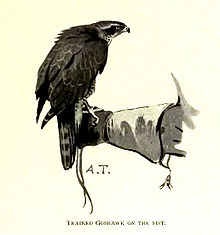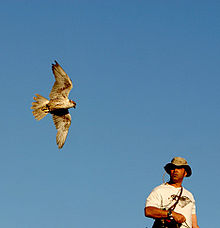

Falconry is the hunting of wild animals in their natural state and habitat by means of a trained bird of prey. Small animals are hunted; squirrels and rabbits often fall prey to these birds. Two traditional terms are used to describe a person involved in falconry: a "falconer" flies a falcon; an "austringer" (Old French origin) keeps Goshawks and uses accipiters for hunting. In modern falconry, the red-tailed hawk (Buteo jamaicensis), Harris's hawk (Parabuteo unicinctus), and the peregrine falcon (Falco perigrinus) are some of the more commonly used birds of prey. The practice of hunting with a conditioned falconry bird is also called "hawking" or "gamehawking", although the words hawking and hawker have become used so much to refer to petty traveling traders, that the terms "falconer" and "falconry" now apply to most use of trained birds of prey to catch game. However, many contemporary practitioners still use these words in their original meaning.
In early English falconry literature, the word "falcon" referred to a female peregrine falcon only, while the word "hawk" or "hawke" referred to a female hawk. A male hawk or falcon was referred to as a "tiercel" (sometimes spelled "tercel"), as it was roughly one-third less than the female in size.[1][2] This traditional Arabian sport grew throughout Europe. Falconry is also an icon of Arabian culture. The saker falcon used by Arabs for falconry is called by Arabs "Hur" i.e. Free-bird,[citation needed] and it has been used in falconry in the Arabian Peninsula since ancient times. Saker falcons are the national bird of the United Arab Emirates, Saudi Arabia, Qatar, Oman and Yemen and have been integral to Arab heritage and culture for over 9,000 years. They are the national emblem of many Arab countries.[3][4]
- ^ Bert, E. (1619), An Approved Treatise on Hawks and Hawking.
- ^ Latham, S. (1633), The Falcon's Lure and Cure.
- ^ Syz, Francesca (20 June 2021). "Why peregrine falcons are the ultimate status symbol in the Middle East". The Telegraph. Archived from the original on 2023-11-14. Retrieved 2023-10-12.
- ^ "Saker Falcon entry at Abu Dhabi Environment division". Archived from the original on 2023-11-14. Retrieved 2023-10-12.